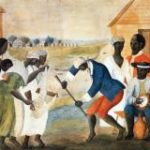If you are lesson planning for the school year, or getting ready to celebrate Juneteenth — the June 19 holiday recognizing the abolition of slavery — this Share My Lesson collection has what you need to teach preK-12 students the history of American slavery. This preK-12 lesson and activity curated collection is in response to a Southern Poverty Law Center report, “Teaching Hard History: American Slavery,” that shows that schools are failing to teach American Slavery. This collection of resources features some of our partner and users’ best material to ensure schools and teachers have the support they need to teach about the history of American slavery.
Slavery: No Freedom, No Rights (Lesson Plan)
Examine the history of slavery in the United States. Trace the development and expansion of slavery in the 19th century and learn about the conflicts and compromises that occurred prior to the Civil War and the abolition of slavery.
From the basics about slavery to the attitudes that defended it and the efforts of those who wanted to see it abolished, in this lesson students learn about this dark part of America’s past.
** Please note: The section about the Missouri Compromise and the Compromise of 1850 has been moved to a new mini-lesson called Slave States, Free States that explores the debate about the expansion of slavery. We recommend teaching this mini-lesson along with the Slavery lesson. Find it in our Geography Library.
13th Amendment: Abolition of Slavery
Slavery was embedded into America’s fabric by the time of the ratification of the Constitution. Do you think this affected how long slavery lasted in America and how it ended? Explore the National Constitution Center’s 13th Amendment Learning Module to learn more.
How Did the Constitutional Convention Deal with Slavery?

This short video explains the differing perspectives that emerged about the Constitution and slavery. Some, like Frederick Douglass, believed that the Founders put slavery on the road to extinction while others, like Roger Taney, believed that the Constitution was a slaveholders’ document. Professor Gordon Lloyd contends that the slavery clauses in the Constitution both limited and expanded slavery’s impact, and that the Founders alone do not bear responsibility for slavery’s later expansion.
District of Columbia Compensated Emancipation Act of 1862
The 150th anniversary of the District of Columbia Compensated Emancipation Act of 1862
occurred in 2012. This bill was introduced to Congress to end slavery in the District of
Columbia. Many citizens and members of Congress alike noted that the legality of slavery in
the District of Columbia was inconsistent with the ideals and aspirations of the nation. Congress
approved the bill, and President Abraham Lincoln signed the act.
This activity features the District of Columbia Compensated Emancipation Act of 1862 and
other primary and secondary sources that tell the story of Congress’s role in this first major step
toward the freeing of enslaved African Americans. While intended for 8th grade students, the
lesson can be adapted for other grade levels.
States, Slavery, and the Constitution

This short video assesses sectional differences at the Convention about slavery. New England delegates saw slavery as a moral issue beyond the scope of their deliberations; representatives from the Middle States were generally opposed to slavery on moral and economic grounds; and Southerners were insistent on protection for both slavery and the slave trade. Professor John Kaminski analyzes how the conflict was resolved by denying Congress any power to regulate the trade until 1808.
The Constitutional Convention: Slavery and the Constitution
History is the chronicle of choices made by actors/agents/protagonists in specific contexts. This simulation places students at the Constitutional Convention and asks them to engage in the most problematic issue the framers faced: how to deal with slavery. Although most delegates believed slavery was deplorable, it was so deeply entrenched that any attempt to abolish it would likely keep several states from approving the proposed Constitution. By confronting this issue, students will experience for themselves the influence of socioeconomic factors in the political arena, and they will see how political discourse is shaped by arguments based on morality, interest, and pragmatic considerations, often intertwined.
Slavery a Positive Good, John C. Calhoun

John C. Calhoun was a U.S. statesman and spokesman for the slave-plantation system of the South. He explains in this article that slavery gives people more serious opportunities to better themselves because of slaves. This source allows students to examine the supposed justifications for slavery and challenge the assumptions made by slaveowners.
Modern Day Slavery: Human Trafficking
Students will learn about human trafficking in the United States and read a short profile of human trafficking survivors as they think about the human rights that are violated in this modern form of slavery.
Women & the American Story: A Nation Divided, 1832-1877
This free curriculum unit from the New-York Historical Society delves into the ways women participated in all aspects of the Civil War and on both sides of the conflict, from the early debate over the expansion of slavery through the end of federal Reconstruction. Materials examine this pivotal moment in American history through the experiences of diverse women and consider how the war and then Reconstruction policies shaped their lives.
